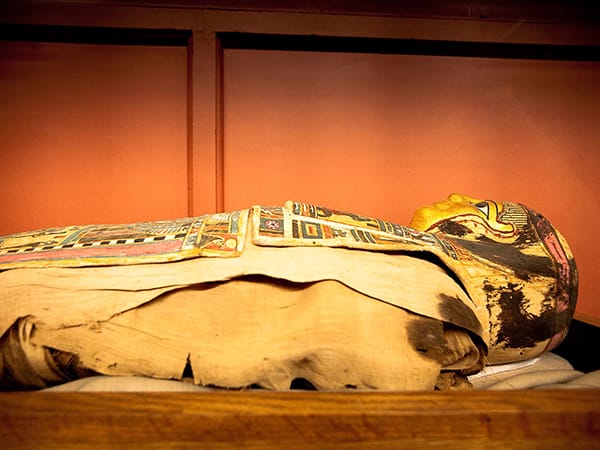
Life on Earth
 Conchologycitus: The Abe Levine Shell Collection
Conchologycitus: The Abe Levine Shell Collection
The Hodgson Gallery, second floor
Showcasing over 1,200 gem-quality shells, this exhibit honours the philanthropy of Abe Levine, Quebec's premier mollusc collector.
Read an article about this collection and the collector: Abe Levine.
 Water is Life
Water is Life
The Dawson Gallery, second floor
This exhibit about water resources and conservation was created with support from the McGill Sustainability Projects Fund. To learn more about Montreal's water, listen to an interview about the Water is Life project (courtesy of CKUT 90.3 FM), visit the Water is Life website, or ask about our self-guided audio tour focusing on water at McGill.
 Dinosaurs and prehistoric beasts
Dinosaurs and prehistoric beasts
The Dawson Gallery, second floor
Fossil specimens from the Museum's collections reveal some of the most remarkable events in the history of life on Earth: from the earliest trace fossils in the Ediacaran of Newfoundland, to the strange creatures of the Burgess Shale that arose from the Cambrian explosion in the Rocky Mountains. From the Devonian expansion of life from the sea onto land at Miguasha, the Gaspé, and Joggins, Nova Scotia to the rise of the dinosaurs in western Canada. From the mammoths of the last ice age to the whales of the post-glacial sea that covered the St. Lawrence Lowlands and River Valley.
Featured dinosaur specimens include a full-size Gorgosaurus libratus, a Triceratops skull (collected under permit from the Royal Saskatchewan Museum), Dromaeosaurus albertensis, a relative of the well-known Velociraptor, and the skull of Tyrannosaurus rex. Soaring above it all is Robert Lang's impossibly intricate origami model of a Pteranodon, among the largest species of flying reptiles to have ever darkened the skies.
 The Darwin letter
The Darwin letter
The Dawson Gallery, second floor
Donated by the Estate of the late Dr. Bruce Trigger (McGill Anthropology), and his wife Dr. Barbara Welch (McGill Geography), a handwritten letter and photogravure from 1877 form the centrepiece of this exhibit about Charles Darwin's connections to McGill. Accented with fossils, a herbarium specimen (on loan from the McGill Herbarium), and the 4th edition of Darwin's landmark book On the Origin of Species by Means of Natural Selection (on loan from McGill Rare Books and Special Collections), this exhibit highlights the important role of natural history collection, documentation, and preservation in 19th century science.
 Endangered and extinct species
Endangered and extinct species
The Dawson Gallery, second floor
This exhibit includes a number of extinct species: two mounted passenger pigeons (Ectopistes migratorius), a juvenile Labrador duck (Captorhynchus labradorius) and the Eskimo curlew (Nmenilus borealis). In the entrance hall of the museum, there is also a Carolina parakeet (Cornuropsis carolinensis) and isolated bones of a Steller’s sea cow (Hydrodamalis gigas).
 Quebec's biodiversity
Quebec's biodiversity
Back of the Dawson Gallery, second floor
Biodiversity comprises all forms of life on Earth: mammals, reptiles, plants, insects, fungi, bacteria, algae – and humans as well. Species must constantly interact with one another simply to continue to exist. Our successful survival depends entirely on biological diversity and the resources that our planet provides. This exhibit about Quebec's Biodiversity increases awareness of and re-asserts respect for the province's natural environment.
Earthly Treasures
 Minerals from Quebec
Minerals from Quebec
The Hodgson Gallery, second floor
Quebec has produced a greater variety of minerals than any other region in Canada. This exhibit includes minerals from several world-famous localities. The oldest mineral collection in the Redpath Museum, dating to the late 1820s and early 1830s, consists of 2,200 specimens collected by Andrew Fernando Holmes (1797-1860), McGill’s first dean of medicine. A keen amateur naturalist, Holmes also assembled a herbarium of the native plants of the Montreal area. His herbarium and mineral collection were purchased by McGill in 1856. The personal natural history collection of Sir William Dawson (1820-1899), which he brought to McGill in 1855, also contained minerals. Other mineral specimens were added by field collecting, donation and purchase. When the Redpath Museum was inaugurated in 1882, the mineral collection was prominently displayed in the present Dawson Gallery.
The beginning of the 20th century saw a major expansion of the museum’s mineral collection. The Harrington Collection of 4,300 mineral specimens was purchased for the museum in 1905 by Dr. James Douglas (1837-1918). Bernard J. Harrington (1848-1907) was then professor of chemistry and mineralogy at McGill. The same year saw the purchase of the Ferrier Collection through the generosity of Sir William Macdonald (1831-1917) and Dr. Douglas. This outstanding collection of 7,000 mineral specimens was assembled by mining engineer Walter F. Ferrier (1865-1950), an 1887 McGill graduate. In 1921, the Montreal newspaper baron Lord Atholstan (1848-1938) donated the Lionel H. Shirley mineral collection, and in 1925 the museum received the mineral collection of the Natural History Society of Montreal. In recent years, the Redpath Museum has been the recipient of important donations of minerals from famous Quebec mineral localities, including Mont Saint-Hilaire, the Francon quarry in Montreal, and the Jeffrey mine in Asbestos.
 World Cultures
World Cultures
Third floor
There are approximately 1000 cultural objects (household and ceremonial items, ornaments, musical instruments) displayed in the Museum’s World Cultures (Ethnology) Gallery, including archaeological material from ancient Egypt, the Mediterranean, and Mesoamerica, and 19th and 20th century artefacts from Asia, Oceania, South America, and Africa. Many of these objects have been in McGill University’s collections for over one hundred years.
The Egyptian exhibits feature two New Kingdom mummies circa 1500 BCE, a Ptolemaic mummy (330-30 BCE), several mummified animals, and an interactive computer display on mummies and Ancient Egypt.